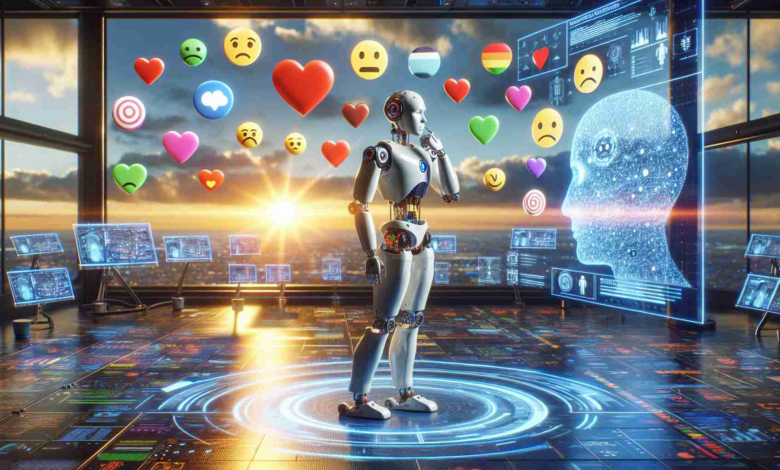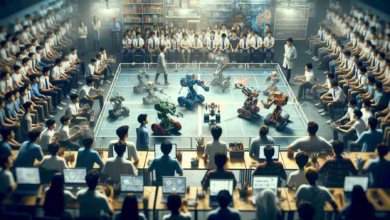Pioneering Emotional Intelligence in Robotics: The Rise of Emo

In a breakthrough for robotics and artificial intelligence (AI), a robot named Emo stands as a testament to technological ingenuity, possessing the capability to learn and replicate human emotional expressions. This development marks a significant stride in narrowing the emotional divide between humans and machines, potentially reshaping the way we interact with robots in a multitude of sectors.
Core Innovation Behind Emo’s Emotional Acuity
Emo’s core innovation lies in its dual neural network architecture, which empowers the robot with unprecedented emotional intelligence. By utilizing advanced cameras and motor systems, Emo can observe and assimilate human expressions. Over time, its capacity to respond in contextually relevant ways improves, making human-robot interactions increasingly natural and seamless.
Professor Hod Lipson and his team are the visionaries behind Emo’s conceptualization and realization. Their work paves the way for a future where robots can forge emotional bonds with humans, setting a new benchmark in social robotics.
Potential for Transformative Impact Across Industries
The ripple effect of Emo’s introduction is vast, with implications for customer service, therapy, elder care, and education. It foretells significant growth within the social robotics market, with affordable manufacturing techniques on the horizon and analysts predicting robust market development bolstered by the integration of empathetic robots in everyday life.
Navigating the Ethical Considerations of Advanced Robotics
Notwithstanding the advancements and promises of Emo’s technology, ethical questions loom. Issues surrounding emotional authenticity, privacy, and employment disruptions accentuate the need for conscientious deployment of such robots. This underscores the importance of engaging with ethics-focused organizations like IEEE and ACM, which strive to establish standards that balance technological progress with societal well-being.
In summary, Emo represents a fusion of AI and emotional perception, potentially revolutionizing human-robot interaction and industry practices. Its advent warrants thoughtful consideration of the ethical landscape as we embrace the age of emotionally intelligent machines. The robotic companion’s evolution and the industry’s path forward will be characterized by ethical vigilance, research brilliance, and insightful analysis, jointly shaping the role of robotics in our future.
Expanding the Market Forecast for Emotionally Intelligent Robots
The global market for social and emotional robotics is expected to experience substantial growth over the coming years. According to a report by MarketsandMarkets, the social robot market, in particular, is expected to rise from USD 918 million in the current scenarios to over USD 3,900 million by the next decade, expanding at a CAGR of 14.5% during the forecast period. This growth is fueled by increasing adoption in sectors such as personal assistance, education, and healthcare, where they can perform tasks ranging from companionship to assisting with cognitive therapy and rehabilitation.
The emergence of robots like Emo will spur further research and development, reducing costs and enhancing functionalities. This will likely attract investment and increase the accessibility of these robots, thus making them more commonplace in both consumer and commercial environments.
Challenges and Controversies Within the Robotics Industry
Despite these promising market forecasts, the robotics industry faces challenges and controversies that could impact the emotional intelligence sector. One of the primary concerns is job displacement, as robots become capable of performing tasks typically reserved for human workers. This could lead to significant shifts in the labor market and necessitate retraining for those whose jobs are affected.
Another key consideration is data privacy and security, especially with robots that can collect and analyze personal emotional data. Ensuring that this information is used responsibly and securely is paramount to maintaining public trust.
For research, development, and the establishment of standards in robotics, resources can be found through organizations such as IEEE and ACM.
Summary and Industry Outlook
In conclusion, Emo exemplifies the potential for emotion recognition in robotics to drive innovation across various sectors. The social and emotional robot industry is anticipated to flourish, bringing about advancements in how these machines are integrated into our daily lives. As the industry progresses, it will be essential to monitor market dynamics, foster ethical practices, and encourage responsible innovation, thereby ensuring that the evolution of robots like Emo contributes positively to society.
The success of products like Emo and the industry’s trajectory will heavily rely on striking a balance between innovation and the humane and ethical application of technology. Thought leaders, developers, and policymakers will need to collaborate to navigate these challenges successfully. The trends in the robotics industry point towards a future where emotionally intelligent machines become an integral part of the fabric of society, enhancing human life while addressing the ethical implications of such profound technological integration.

Leokadia Głogulska is an emerging figure in the field of environmental technology, known for her groundbreaking work in developing sustainable urban infrastructure solutions. Her research focuses on integrating green technologies in urban planning, aiming to reduce environmental impact while enhancing livability in cities. Głogulska’s innovative approaches to renewable energy usage, waste management, and eco-friendly transportation systems have garnered attention for their practicality and effectiveness. Her contributions are increasingly influential in shaping policies and practices towards more sustainable and resilient urban environments.



